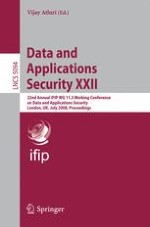This volume contains the papers presented at the 22nd Annual IFIP WG 11.3 Working Conference on Data and Applications Security (DBSEC) held in L- don, UK, July 13–16, 2008. This year’s working conference continued its tra- tion of being a forum for disseminating original research results and practical experiences in data and applications security. This year we had an excellent program that consists of 9 research paper s- sions with 22 high-quality research papers, which were selected from a total of 56 submissions after a rigorous reviewing process by the Program Committee members and external reviewers. These sessions included such topics as access control, privacy, auditing, systems security and data security in advanced app- cation domains. In addition, the programincluded a keynote address, an invited talk and a panel session. The success of this conference was a result of the e?orts of many people. I would like to extend my appreciation to the Program Committee members and external reviewers for their hard work. I would like to thank the General Chair, SteveBarker,fortakingcareoftheorganizationaspectsoftheconferenceandfor arranging the keynote address and the panel session. I would also like to thank Claudio Ardagna for serving as the Publicity Chair and for promptly updating the conference Web page, and Don Lokuadassuriyage for serving as the Local Arrangements Chair. Special thanks go to Alfred Hofmann, Editorial Director at Springer, for agreeing to include these conference proceedings in the Lecture Notes in Computer Science series.
